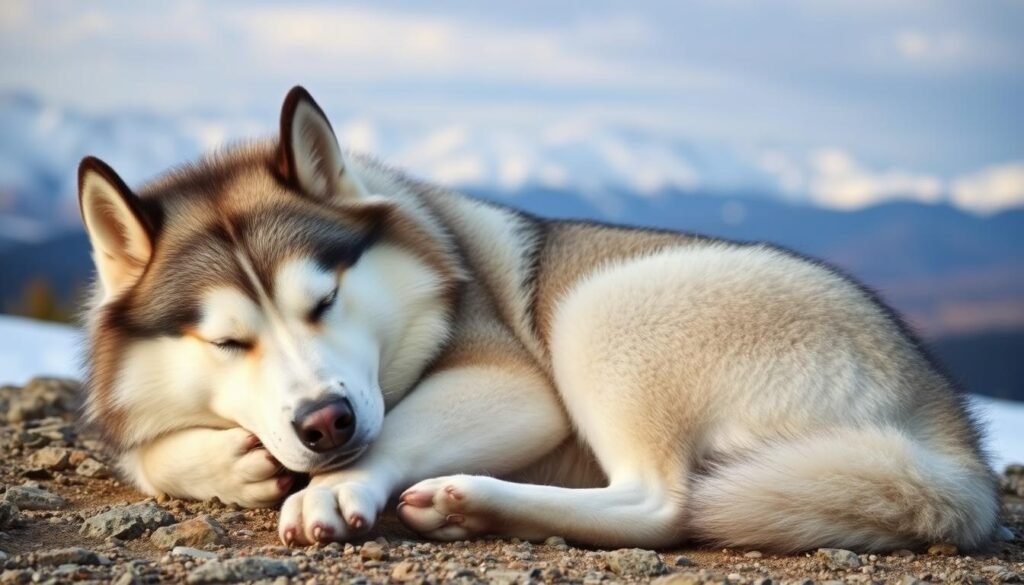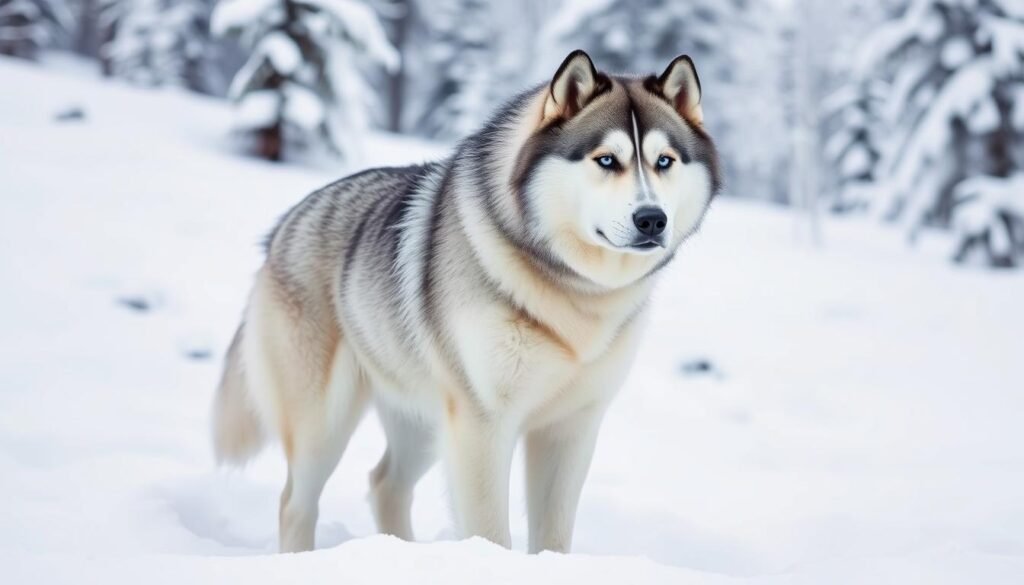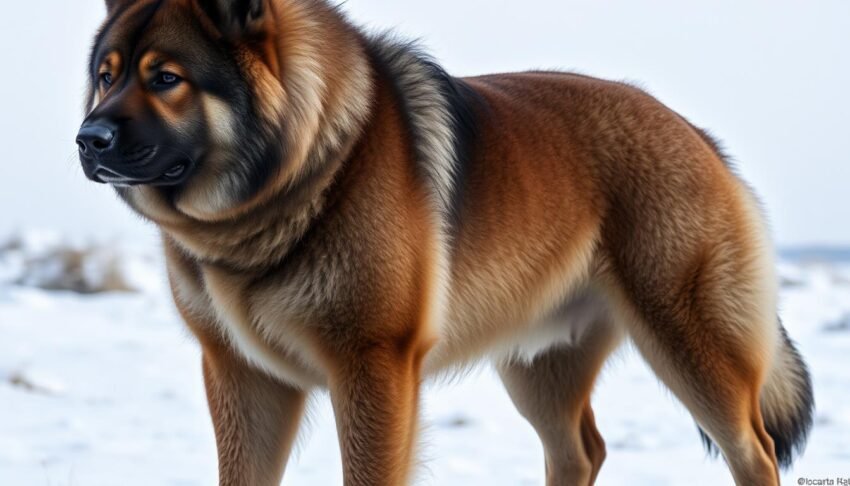The Alaskan Malamute is a breed known for its strength, endurance, and captivating appearance, making it a loyal companion for adventurous souls. As you consider bringing an Alaskan Malamute into your life, you’ll discover that this breed has captured the hearts of dog enthusiasts worldwide with its rich history and strong bond with humans. With their origins in the Arctic regions, Alaskan Malamutes have been bred for strength and endurance, making them ideal companions for hiking, sledding, and other outdoor activities.
As an adventurous soul, you’ll appreciate the Alaskan Malamute’s loyalty and affection towards their human family members. This breed is perfect for those who love the outdoors and are looking for a loyal companion to share in their adventures. Whether you’re hiking, sledding, or simply enjoying the great outdoors, the Alaskan Malamute is the perfect breed for you.
Key Takeaways
- The Alaskan Malamute is a loyal companion for adventurous souls
- This breed is known for its strength, endurance, and captivating appearance
- Alaskan Malamutes have been bred for strength and endurance, making them ideal companions for outdoor activities
- The breed is loyal and affectionate towards their human family members
- Alaskan Malamutes require regular exercise and mental stimulation to thrive
- This breed is perfect for those who love the outdoors and are looking for a loyal companion
Overview of the Alaskan Malamute Breed
The Alaskan Malamute breed has a rich history, originating from the Arctic regions where they were bred by native Inuit tribes for tasks such as sledding and hauling heavy loads. Their strength, resilience, and intelligence made them invaluable to the Inuit tribes, who relied on them for transportation and hunting. Understanding the breed’s history and working background is essential for appreciating their nature and needs.
As you learn about the Alaskan Malamute breed, you’ll discover that their origins date back more than 4,000 years. They were vital during the 1896 gold rush, leading to increased breeding demands. The American Kennel Club (AKC) fully recognized the Alaskan Malamute breed in 1935, acknowledging their unique characteristics and working background.
History and Origins
The Alaskan Malamute’s history is deeply rooted in their purpose as working dogs in the Arctic. They were bred to withstand harsh weather conditions and perform tasks that required immense strength and endurance. Their origins are a testament to their ability to thrive in challenging environments, making them a fascinating breed to learn about.
Purpose and Working Background
The Alaskan Malamute’s working background is characterized by their role in sledding, hauling, and hunting. They were designed to be strong, resilient, and intelligent, making them an essential part of the Inuit tribes’ survival. Their purpose was to assist with daily tasks, and their working background is a reflection of their ability to perform under pressure.
- Average height for males: 25 inches (64 cm)
- Average weight for males: 38 kilograms (84 lb)
- Typical litter size: 4–10 puppies
- Average life expectancy: 11.3 years
By understanding the Alaskan Malamute breed’s history, origins, purpose, and working background, you’ll gain a deeper appreciation for their unique characteristics and needs.
| Characteristic | Value |
|---|---|
| Average height for females | 23 inches (58 cm) |
| Average weight for females | 34 kilograms (75 lb) |
| Typical onset age for canine diabetes | 5 to 7 years |
Distinctive Features of Alaskan Malamutes
As you consider bringing an Alaskan Malamute into your family, it’s essential to understand their distinctive features. One of the most notable aspects of this breed is their size and build. On average, males weigh between 85 to 100 pounds, while females weigh between 75 to 85 pounds. Their height ranges from 23 to 25 inches for females and 25 to 28 inches for males, making them a sturdy and impressive companion.
Their coat colors and patterns are another distinctive feature, with a thick double coat that provides insulation against the cold. This coat comes in various colors and patterns, adding to the breed’s unique appearance. Understanding these physical characteristics is crucial for potential owners who want to know what to expect from their Alaskan Malamute.
- Sturdy build and athletic ability
- Thick double coat for insulation
- Various coat colors and patterns
- Intelligent and strong-willed nature
By understanding these distinctive features, you can better appreciate the unique qualities of the Alaskan Malamute breed and decide if they are the right fit for your lifestyle.
Temperament and Personality Traits
As you consider bringing an Alaskan Malamute into your family, it’s essential to understand their temperament and personality traits. Alaskan Malamutes are known for their loyalty and affection towards their family, making them wonderful companions. However, they can also be independent and stubborn at times, requiring consistent leadership and a clear understanding of their role in the family.
One of the key characteristics of the Alaskan Malamute temperament is their strong sense of loyalty. They bond deeply with their family and are often described as affectionate and playful. Nevertheless, their independence and stubbornness can make training challenging, especially for inexperienced dog owners. With patience, consistency, and positive reinforcement, you can develop a strong and loving relationship with your Alaskan Malamute.
Some key traits to consider when understanding the Alaskan Malamute temperament include:
- Loyalty: They are deeply devoted to their family and can become protective if they feel their loved ones are being threatened.
- Affection: Alaskan Malamutes are known for their affectionate nature and enjoy spending time with their family.
- Independence: They can be strong-willed and independent, requiring consistent training and socialization.
- Stubbornness: Their stubbornness can make training challenging, but with patience and positive reinforcement, you can overcome this trait.
By understanding the Alaskan Malamute temperament and personality traits, you can better prepare yourself for the responsibilities and joys of owning one of these magnificent dogs. With their loyalty, affection, and playful nature, they can bring immense happiness and companionship into your life.
| Trait | Description |
|---|---|
| Loyalty | Deeply devoted to their family |
| Affection | Affectionate and playful |
| Independence | Strong-willed and independent |
| Stubbornness | Can be challenging to train |
Health Considerations for Malamute Owners
As an Alaskan Malamute owner, it’s essential to be aware of the common health issues that can affect your pet. Regular vet visits, preventative care, and a healthy diet are crucial for maintaining their overall Alaskan Malamute health. Some common issues include hip dysplasia, dental disease, and hypothyroidism.
Preventative care is vital in preventing or managing these health issues. This includes regular vaccinations, dental care, and monitoring for signs of illness. By taking proactive steps, you can help ensure your Alaskan Malamute lives a long and healthy life, with an average lifespan of 12 years.
Common Health Issues
- Hip dysplasia, which can lead to arthritis
- Dental disease, affecting 80% of all dogs by age two
- Hypothyroidism, resulting in symptoms like weight gain and behavioral changes
By prioritizing preventative care and being aware of these common issues, you can help keep your Alaskan Malamute healthy and thriving. Regular check-ups with a veterinarian and a balanced diet can go a long way in preventing or managing health issues, ensuring your pet receives the best possible care.

Preventative Care Tips
Some preventative care tips include providing regular exercise, a balanced diet, and regular veterinary check-ups. By following these tips, you can help prevent or manage common health issues and ensure your Alaskan Malamute lives a long and healthy life.
Training an Alaskan Malamute
When it comes to Alaskan Malamute training, patience, consistency, and positive reinforcement are essential. You should start with basic commands, such as “sit,” “stay,” and “come,” and gradually move on to more complex commands. Socialization techniques are also crucial, as they help your Malamute become confident and calm in new environments and around new people and animals.
Here are some tips for training your Alaskan Malamute:
- Start training early, as soon as your puppy is 8 weeks old
- Use positive reinforcement, such as treats and praise, to encourage good behavior
- Be consistent and patient, as Malamutes can be independent and stubborn at times
- Introduce your Malamute to new people, animals, and environments to help them become socialized
Remember, Alaskan Malamute training requires a gentle and consistent approach. With patience, positive reinforcement, and socialization techniques, you can help your Malamute become a well-behaved and loyal companion.
| Age | Training |
|---|---|
| 8 weeks | Basic harness training |
| 3 months | Introduction to basic commands and socialization |
| 7 months | Drag light weights and playful interaction |
Exercise Needs of Alaskan Malamutes
As an owner of an Alaskan Malamute, you should understand that their exercise needs are significant. Alaskan Malamute exercise needs are not just about physical activity but also about mental stimulation. Daily activity is crucial to prevent boredom and destructive behavior in these high-energy dogs.
When considering fun activities for your Malamute, think about their natural instincts as sled dogs. They love to run, pull, and engage in physical exertion. Some fun activities include hiking, agility training, and interactive play. These activities not only provide the necessary exercise but also offer mental stimulation, which is essential for the well-being of Alaskan Malamutes.
Here are some key points to consider when planning exercise for your Alaskan Malamute:
- Daily walks and hikes are essential for physical and mental health.
- Interactive play and training sessions should be included in the daily routine.
- Consider activities like weight pulling and agility training to cater to their working instincts.
Remember, every dog is different, and it’s essential to tailor the exercise routine to your Malamute’s age, health, and energy level. By providing the right amount of exercise and mental stimulation, you can help your Alaskan Malamute lead a happy and healthy life.
Living Arrangements for Malamutes
When it comes to Alaskan Malamute living arrangements, it’s essential to consider their needs for space and exercise. An ideal home environment should provide ample space for the dog to rest and relax, as well as a securely fenced yard where they can run and play. Outdoor space is crucial for Malamutes, as they require regular exercise to stay happy and healthy.
A suitable outdoor space for an Alaskan Malamute should be surrounded by nature, allowing them to thrive in their natural environment. This can include a large yard or access to nearby parks and trails. The ideal home environment should also be well-ventilated and cool, as Malamutes can be sensitive to heat.
In terms of specific requirements, Alaskan Malamute living arrangements should include:
- A securely fenced yard to prevent escape and ensure safety
- Ample space for exercise and play, such as a large yard or nearby park
- A well-ventilated and cool living area to prevent overheating
- Regular access to outdoor spaces, such as trails and parks, for exercise and mental stimulation
By providing an ideal home environment and outdoor space, you can help ensure your Alaskan Malamute leads a happy and healthy life.
Nutrition for Alaskan Malamutes
As an Alaskan Malamute owner, you want to ensure your dog is receiving the best possible nutrition to maintain their overall health. Alaskan Malamute nutrition requires a balanced diet that includes high-quality protein, essential fatty acids, vitamins, and minerals. A recommended diet for Alaskan Malamutes should have a protein content of 21% to 28% for dry dog food and approximately 12% for canned dog food.
When it comes to special dietary needs, Alaskan Malamutes may require additional supplements to support their joint health and immune system. ProDog’s supplement offerings, such as their joint supplement and multivitamin, can provide the necessary support. It’s essential to consult with a veterinarian to determine the best diet for your Alaskan Malamute, taking into account factors such as age, health, and activity level.
A well-balanced diet that meets their nutritional requirements is crucial for maintaining their health and preventing diet-related issues. Some key considerations for Alaskan Malamute owners include:
- Feeding a high-quality protein source
- Providing essential fatty acids for skin and coat health
- Ensuring adequate vitamin and mineral intake
- Avoiding overfeeding and over supplementation
By providing your Alaskan Malamute with a well-balanced diet and considering their special dietary needs, you can help ensure they lead a happy and healthy life.
Grooming an Alaskan Malamute
As an owner of an Alaskan Malamute, you know how important it is to keep your dog’s coat clean and healthy. Regular Alaskan Malamute grooming is essential to prevent matting and tangling of their double-coated fur. This includes bathing between once a week to every six weeks, depending on your dog’s activities and coat characteristics.
Weekly brushing is also necessary to prevent matting and tangling, and to reduce shedding. You should use a firm slicker brush throughout the coat, paying special attention to areas like the thighs, behind the ears, the tail, and around the ruff. Regular coat care can help prevent skin issues and keep your dog’s coat looking its best.
In addition to brushing and bathing, regular nail trimming and ear cleaning are also important parts of Alaskan Malamute grooming. Nail trimming should occur at least every 4 to 6 weeks to ensure healthy foot structure, and ear cleaning can help prevent irritation or infections.
By following these grooming tips, you can help keep your Alaskan Malamute’s coat clean and healthy, and prevent potential skin issues. Remember to always use gentle, dog-specific products and to be patient and gentle when grooming your dog.
Choosing an Alaskan Malamute
When considering bringing an Alaskan Malamute into your family, you have two primary options: Alaskan Malamute adoption or breeding. It’s crucial to choose a responsible breeder who prioritizes the health and well-being of the dogs. This ensures a positive experience for both you and your new pet.
Adopting from a rescue organization or a reputable breeder can be a rewarding experience. Here are some factors to consider when making your decision:
- Research the breed’s needs and characteristics to ensure you can provide the necessary care and attention.
- Understand the differences between Alaskan Malamute adoption and breeding to make an informed decision.
- Look for a responsible breeder who is transparent about the dog’s history, health, and temperament.
By choosing a reputable source for your Alaskan Malamute, you can help ensure a happy and healthy relationship with your new pet. Remember to prioritize the dog’s well-being and your ability to provide the necessary care and attention.

Fun Facts About Alaskan Malamutes
As you learn more about Alaskan Malamutes, you’ll discover their unique characteristics and intriguing pop culture appearances. One of the most interesting Alaskan Malamute fun facts is their strength and endurance, which made them invaluable during World War I and World War II for tasks such as pulling sleds and search-and-rescue missions.
Their intelligence and loyalty have also made them beloved companions, often appearing in films and TV shows. Some notable pop culture appearances include roles in movies like “Balto” and TV series such as “Game of Thrones,” where their majestic appearance and strength are showcased.
Here are a few more fun facts about Alaskan Malamutes:
- They are highly energetic and thrive in cold weather, making them perfect for activities like sledding and hiking.
- Alaskan Malamutes have a thick double coat that sheds significantly, requiring regular grooming.
- They are generally good with children due to their loyal and affectionate nature, but supervision is advised due to their size and strength.
With their rich history, unique characteristics, and appearances in pop culture, it’s no wonder why Alaskan Malamutes have captured the hearts of many dog lovers. Whether you’re an experienced dog owner or just learning about this breed, there’s always something new and exciting to discover about Alaskan Malamutes.
| Characteristic | Description |
|---|---|
| Size | Males: 85-100 pounds, Females: 70-85 pounds |
| Lifespan | 10-14 years |
| Coat | Thick double coat, sheds significantly |
Tips for First-Time Malamute Owners
As a first-time Alaskan Malamute owner, preparing your home and bonding with your new canine companion are crucial steps towards a successful and rewarding relationship. Start by creating a safe and comfortable environment for your Malamute, ensuring they have access to a spacious area with ample room to move and explore. Invest in high-quality chew toys and puzzle feeders to keep your energetic pup mentally stimulated.
Dedicating time each day to engaging in activities that strengthen the bond between you and your Malamute is essential. Go for brisk walks, play fetch, or try training sessions that reinforce basic commands like ‘sit’ and ‘stay.’ These bonding experiences will help your Malamute feel secure and build trust, laying the foundation for a lifelong companionship.
Remember, Alaskan Malamutes require a significant time commitment for exercise, grooming, and training. Be ready to invest at least 30 minutes to an hour of intense daily activity to keep your Malamute healthy and happy. With patience, consistency, and a deep understanding of the breed’s unique needs, you’ll be well on your way to enjoying the loyalty and affection of your new Alaskan Malamute.


